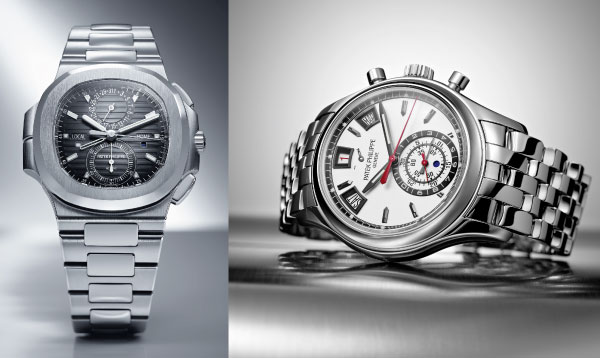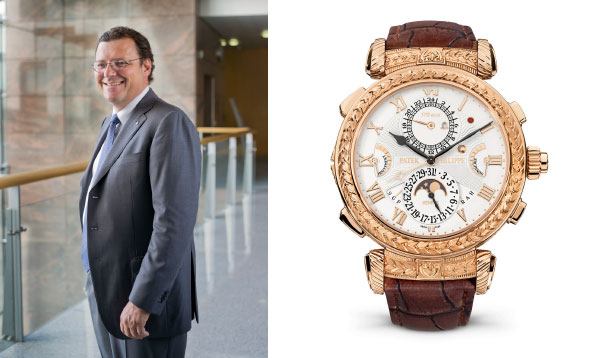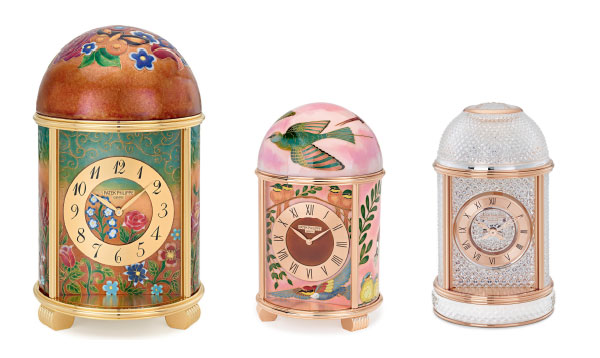
For nearly forty years now, the casually elegant Nautilus has enjoyed iconic status. The physique and resilience of its case have always been among its key characteristics. The integration of horological complications such as an analog date and a moon-phase display boosted its appeal, and in 2006, when Patek Philippe presented the first Nautilus chronograph, it became clear that this timekeeping instrument is what physically active watch connoisseurs had been waiting for. Endowing the automatic chronograph with the Travel Time function that indicates the time in two different time zones at a single glance, Patek Philippe is expanding its collection of complicated Nautilus models. At home, where both times are identical, the two hands of the Ref. 5990 are superposed. The skeleton hand displays home time while the solid hour hand indicates local time. When the owner moves to another time zone, the hour hand for local time can be adjusted in one-hour steps with the plus and minus correctors. This integration of the Travel Time function in the Nautilus chronograph necessitated the redesign of the case and the development of a new movement. In the course of the redesign project, the two chronograph pushers at 2 and 4 o’clock were minimally shifted closer to the crown. In their new positions, they can more directly transmit the commands to the chronograph caliber, and this is clearly discernible in a softer response with clearly defined trigger points. Additionally, the new configuration creates the space needed to integrate a date correction push piece in the bracelet lug at 1 o’clock. All of the complications mentioned above can already be found in other Patek Philippe timepieces, but the way they are combined in the new Nautilus Travel Time Chronograph is a premiere. It called for the development of the new caliber CH 28-520 C FUS movement in which the chronograph mechanism, a traditional column wheel design with an innovative disk clutch, is supplemented with the Travel Time mechanism. This ingenious device dates back to a patent granted to Patek Philippe in 1959. It not only facilitates the bidirectional adjustment of local time in one-hour increments, but is also totally isolated from the going train when time-zone settings are changed. This prevents adverse effects on the amplitude of the balance and the rate accuracy of the watch. The date display coupled with local time has been repositioned to 12 o’clock as an analog date, and the monocounter at 6 o’clock was converted into a 60-minute counter. This metamorphosis was implemented with 47 additional parts. Nonetheless, the movement is merely 0.3 mm higher than its predecessor. Not least, this is due to the escapement in which the voluminous overcoiled Breguet balance spring was replaced with the patented Patek Philippe Spiromax® hairspring made of Silinvar®. Thanks to its intelligent geometry, it oscillates in one plane – yet symmetrically and isochronously.
Patek Philippe’s stainless steel watches have always ranked among the most desirable timepieces because they were crafted only in small numbers. The brand news Annual Calendar Chronograph is one of the manufacture’s rare classically elegant wristwatches outside the casually exclusive Nautilus and Aquanaut collections that combine a complicated movement with a stainless steel case. This new version will also replace all current gold and platinum versions of the Annual Calendar Chronograph. Technical elegance characterizes the new silvery-gray dial with its striking red accents, interesting bright-dark contrasts, and the dynamic, performance-oriented looks of its explicitly three-dimensional architecture. An uncommon feature in a Patek Philippe watch : the red “1” in the date aperture, which kicks off each month with a colorful stimulus while the dates from the 2nd to the 31st days are displayed black on white. It is a genuine premiere for Patek Philippe, as is the combination of an annual calendar chronograph with a steel case and the stainless steel “drop” links bracelet that underscores the functionality of the Ref. 5960 as a measuring instrument. The movement is a prime example of tradition paired with innovation. It combines the classic column-wheel control concept with a modern vertical disk clutch that eliminates the risk of hand jump or recoil when the stopwatch function is activated. The clutch is practically friction-free, so that the chronograph hand can be used as a permanently running seconds hand if desired. The patented Spiromax® balance spring made of Silinvar® is another innovative feature. Its isochronous oscillation, low mass, antimagnetic properties, and unique geometry assure high rate stability and uniformity. These are ideal prerequisites for the fulfillment of the Patek Philippe Seal precision criteria which for mechanical movements of this size tolerate a rate deviation of no more than -3 to +2 seconds per day.

Quite often, the dial is referred to as the face of a watch and largely influences the overall impression that a timepiece makes. Accordingly, dial-makers rank among the most sought-after specialists in the realm of horology and, especially at Patek Philippe, have very close-knit relationships with the Manufacture. When Patek Philippe, for a lack of successors in the founding families, was up for sale in the early 1930s, the Geneva-based dial Manufacture Stern Frères was among the seriously interested prospects. At that time, it was probably the best and most famous dial specialist in the Swiss watchmaking industry. Patek Philippe was one of its customers. Stern Frères was also domiciled in Geneva, and the owners of both companies knew and trusted each other. Consequently, the founding families confidently entrusted Patek Philippe to the hands of the Stern brothers in 1932. The Stern family remained loyal to the “face of the watch” as evidenced by the many amazing creations presented since 1932 : dials with cloisonné enamel or miniature enamel painting, guilloched or gem-set oeuvres, and meanwhile even precious wood marquetry of the most filigreed kind. President Thierry Stern, the fourth-generation member of the family at the helm of Patek Philippe, makes it abundantly clear that he has not replaced dialmaker DNA with watchmaker DNA : he has both. For this reason, Patek Philippe operates its own dial Manufacture which produces artistic creations like the faces of the Calatrava Notre Dame de Paris special edition, the new Haute Joaillerie Calatrava or the the remarkable Twenty~4® Haute Joaillerie. They also illustrate that Patek Philippe’s ateliers need not shun the comparison with the world’s most eminent jewelry houses. Excellence permeates the creativity of the designs, the quality and orchestration of the precious stones, the fixation of the gems in traditional bead and closed settings or gridless pavé and the extremely complex and risky invisible setting technique.
Nautilus Travel Time Chronograph Ref. 5990/1A
Case : stainless steel, bezel with vertical satin finish and polished chamfer, sapphire-crystal case back, water-resistant to 120m Size : 45,5×45,7mm Movement : self-winding mechanical movement (caliber CH 28-520 C FUS with max 55h power reserve), column-wheel chronograph with disk clutch, 370 parts, central rotor in 21K gold, Patek Philippe Seal Functions : home-time hour hand (lower hand), local-time hour hand (upper hand), and minute hand from the center, minutes, seconds, chronograph, date, day/night indicators for local time at 9 and for home time at 3 Dial : black brass with bright-dark gradation with horizontal embossed pattern and hour markers in 18K white gold with luminous coating Bracelet: satin-finished/polished stainless steel with Nautilus foldover clasp
Annual Calendar Chronograph Ref. 5960/1A
Case : stainless steel, sapphire-crystal case back, water-resistant to 30m Size : 45,5×45,7mm Movement : self-winding mechanical movement (caliber CH 28-520 IRM QA 24H with max 55h power reserve), column-wheel chronograph with disk clutch, 456 parts, central rotor in 21K gold, Patek Philippe Seal Functions : hours, minutes, seconds, chronograph, date, month (between 1 and 2) day/night indicator at 6 Dial : two-tone style, ebony black and silvery opaline and hour markers in black oxidized white gold, subsidiary dial with hour-counter scale on ebony-black oxidized applique in 18K white gold Bracelet : stainless steel, with Patek Philippe “drop” links and stainless steel foldover clasp
Calatrava Haute Joaillerie Ref. 4895R
Case : 18K rose gold with 162 baguette diamonds (5.62 ct), sapphire-crystal case back, water-resistant Size : 34mm Movement : hand-wound mechanical movement (caliber 215 with 44h power reserve), Patek Philippe Seal Functions : hours, minutes Dial : black lacquer in 12 coats, 12 arrow hour markers in 18K rose gold Bracelet : Shiny black alligator strap with large square scales, rolled-edge, 18K rose gold prong buckle with 20 flawless Top Wesselton baguette diamonds (0.72ct).
Twenty~4® Haute Joaillerie Ref. 4909/110 “AQUATIC LIFE”
Case : 18K white gold with 46 closed-set flawless Top Wesselton baguette diamonds (3.97ct), water-resistant Size : 34mm Movement : hand-wound mechanical movement (caliber 16-250 with 38h power reserve), Patek Philippe Seal Functions : hours, minutes Dial : 18K white gold, fully paved, 41 invisibly set flawless Top Wesselton baguette diamonds (1.97 ct), 2 closed-set navette-cut sapphires (0.07ct), 32 bead-set sapphires (0.12 ct) Bracelet : 694 closed-set flawless Top Wesselton baguette diamonds (30.81 ct), 855 closed-set brilliant-cut diamonds (1.7 ct), 31 closed-set navette-cut sapphires (3.48 ct), 236 bead-set sapphires (1.63 ct)
Calatrava Notre Dame de Paris Ref. 5077-099
Case : 18K white gold, sapphire-crystal case back, water-resistant Size : 38mm Movement : hand-wound mechanical movement (caliber 240 with 48h power reserve), Patek Philippe Seal Functions : hours, minutes Dial : decorated with Grisaille au blanc de Limoges technique (white enamel applied on dark base with a needle, building up designs in a monochrome gradient, paler as the thickness of the layer of light color increases), integration of 24k gold dust Bracelet : Shiny black alligator strap with large square scales, hand-stitched, 16 mm prong buckle in platinum





